B2B SaaS has grown in popularity steadily since the early 2000s. With that growth, industries have become more competitive, making SEO rankings in Google’s search results (SERPs) harder and harder to come by.
But gone are the days of quick SEO tricks and hacks to get a first page or top rankings.
As search engines have matured, it has become harder and harder to get and maintain top rankings. Today, you need a holistic SaaS SEO strategy and approach that not only drives visitors but drives signups.
Not to mention your MRR (monthly recurring revenue). MRR is the currency of B2B SaaS.
Hit those lofty goals of six figures, $41.3k, $83k, $100k, and finally, seven-figure MRR.
Then, you’re truly off to the races.
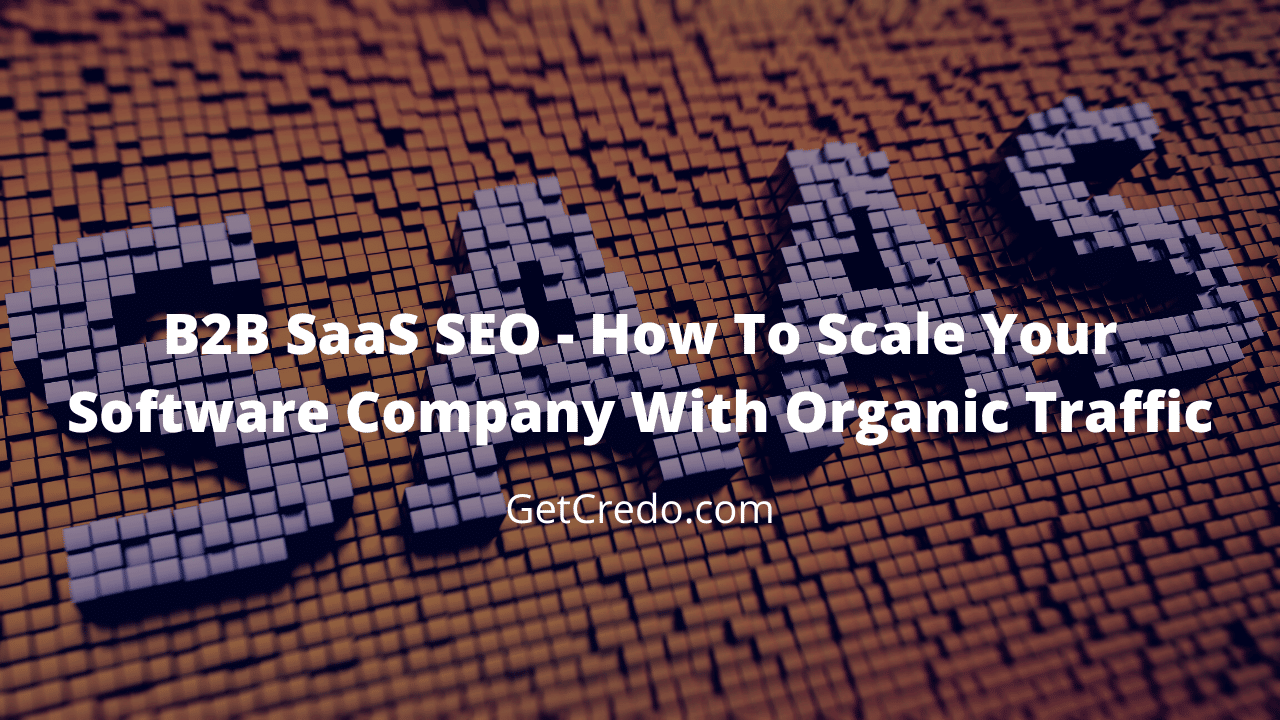
So how do you, B2B SaaS founder or head of marketing, use SEO to drive B2B SaaS signups and revenue?
That’s what we’re going to cover today.
[Want a specialized SaaS digital agency to help streamline this process? Yes, I want a professional’s touch.]
Table of Contents
SEO Fuels Successful SaaS Companies
Here’s how it works:
- Focus on high-intent keywords;
- Bake promotion into your strategy;
- Think outside your website;
- Get the three pillars of SEO right;
- Focus on conversions – and measuring them!
As we get into those, I want you to remember a couple of things.
First, you’re in B2B SaaS. You’re maybe carving out a new market or meeting a need for an existing market in a new way. However, you’re probably entering a market that already has some competitors.
You’re used to doing new things, but when it comes to SEO you don’t need the latest and greatest. To succeed, you just need a solid strategy that you can execute consistently.
And second, SEO is a proven channel. It’s not a new thing to test out and see if it works.
“Trying it out” for a couple of months won’t get you there. SEO is a long-term commitment that you execute to drive results for the long term.
If you’re looking for quick results, then you’re probably better off investing in Facebook Ads and Google Ads.
If you’re building for the long term, then SEO will likely be the best channel for you to grow.
The Three Core Pillars of SEO
To do SEO well, you need to think about the three core pillars of SEO.
You need to do it in a focused way. A way that gets you the most return from your efforts the fastest.

Focus on High-intent Keywords
SEOs often talk about using rankings to drive a large volume of traffic.
In B2B spaces though, there is often not a lot of search volume for any major term. To achieve more traffic to your site you need to make a large investment over a long period of time.
This is why, with B2B SaaS SEO, it’s important to focus on high-intent keywords.
While ranking number one for that keyword may only drive 100 clicks in that month, you know that a relatively high percentage (10-20%) are going to become users.
Do this 10 times over with various keywords and you’re at 100+ new signups per month. Depending on your price point, this can mean a solid base of profitable growth off of which to grow.
So what is a high intent keyword and how do you target it?
Types of Keywords
You might be familiar with the types of keywords, which I usually lump into two buckets:
- Transactional
- Informational
These two are too simplistic. Especially once you get into executing against an SEO strategy.
A better way to think about keywords you pursue is intent. As in, “how motivated to sign up for my product is the person who is searching this term?”
High intent keywords are your traditional transactional keywords like [online event management] but they also go deeper than that to buckets of keywords like:
- Alternatives – e.g. competitor alternative pages;
- Competitor vs competitor pages – your product is offered as a third option;
- How to do (think your product does) blog posts.
On the last point, these are traditionally seen as “informational” keywords.
However, you’ll also capture a percentage of people searching this who think they want to do it themselves. Then they realize it’s easier (and maybe cheaper) to just use your software to do it instead.
By focusing on intent, regardless of if it’s a feature page or a blog post, or a larger guide, you can be sure that you are targeting your potential customers at a point where they’re considering a solution like yours.
When thinking about content for your company, consider a scale from 1-10 where 1 content is extremely relevant and high intent. 10 content is not very relevant to your offering, but your ideal customer also has that problem.
Start with 1 content and over time work your way across the scale to less relevant (but may be higher traffic) content.
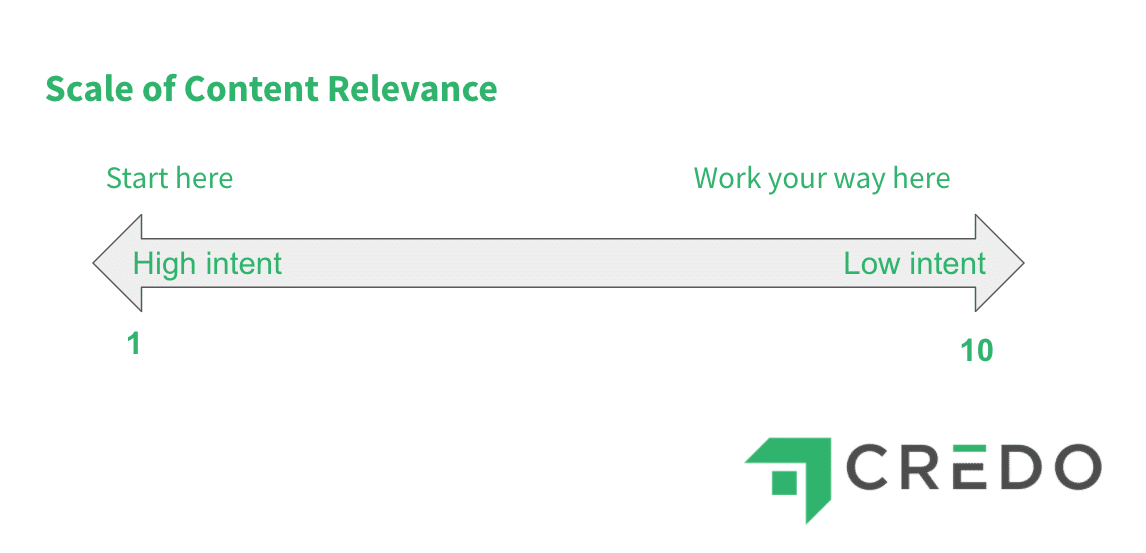
Promotion Rules Everything
In the past, it was possible to easily achieve top rankings by building on a trusted platform, writing some “SEO blog posts,” and building some backlinks to your site via some form of link-building strategy.
Today, it’s harder to get SEO results without building a strong brand, product, and website.
I’m not saying that Google takes conversion and time-on-site metrics into account for rankings, but I’m also not not saying that.
They definitely track when someone loads up a page and quickly goes back to the search results, so honestly it wouldn’t surprise me.
So, it’s not just about getting the click.
It’s about keeping the click, about keeping those eyes on your brand.
Links are still the currency of the web for SEO, but over time we’ve seen them become less and less effective when decoupled from other activities that drive awareness about your brand.
Just getting a bunch of anchor text links back to your site isn’t going to show as good of results as having a volume of consistent quality links back to your site from interviews and podcast appearances coupled with occasional news stories and an active content engine on your site.
As you can tell, just having good onsite SEO and producing a bunch of content isn’t enough.
Build Backlinks For Better SEO
You’re missing the third core pillar of SEO which is a promotion that also builds backlinks to your website to improve your website’s authority in the eyes of the search engines.
But the promotion and link-building strategies I am about to share with you are very different from the link building and promotion advice you’ll hear most “SEO experts” talking about.
That’s because that advice you’ve seen over the years is generic and ultimately super tactical but won’t last and will get abused by so many online that it’s not going to be worthwhile for you to do, both for links and for the sake of your brand.
Here are a few ways to promote your content and your website that won’t risk your site’s rankings:
- Be a podcast guest and make sure to mention various resources on your website. Most podcasts create show notes and link to “resources mentioned”, so you can get links to multiple pages on your site from one interview.
- Get a column on a well-read website. Many of these links are nofollowed by default, but the recognition and referral traffic will far outweigh any “lost link juice”.
- Speak at conferences (especially virtual conferences). You’ll build your brand and get at least a link back, plus will likely be mentioned in emails and recaps sent which gives you extra exposure.
Think Outside The Box (And Your Website
If you’ve been paying attention to Google’s search results over the last few years, you likely noticed that the search results have become a lot more complex.
Long gone are the 10 blue links of old.
In pretty much any semi-competitive space, you’re going to see some combination of:
- Ads (2-4 depending on the keyword)
- Top stories/interesting Finds (content)
- Traditional organic results
- People also ask dropdowns
- Ads at the bottom
There may also be videos and other mixed media throughout. If you’re in a major metro area and the keyword searched could have local intent, you may even see a Map with three local listings.
The point is that SEO has become an increasingly complex process. Relying on just your own website to build your audience and for discovery is like playing a video game on hard mode.
Some of you might be thinking that you prefer playing video games on hard mode. But in business?
The person who succeeds by going through the most suffering doesn’t get anything different (other than maybe some more experience and wisdom for the next time around).
Just think Occam’s Razor:
The simplest explanation that will account for a circumstance or event is most likely the correct explanation.
Business is hard enough as it is, so take every advantage you can. You can bet your competitors sure are.
But I digress.
Understand That Website Ranking Is Getting Harder
You are of course trying to rank your own website, but there’s a lot of real estate on every search result and thus you need to be asking these questions (among others):
- Is Google showing Youtube/video results for this query? If so, do I have a video on Youtube about this topic?
- Are People Also Ask questions showing? If so, do I have content on my site covering that topic well?
- Are Top Stories showing? If so, am I prioritizing being there with editorial content even if I’m trying to rank a more transactional page/URL in the regular organic?
- Even if I’m “ranking well” in the regular organic listings, am I receiving any traffic? If not, how can I diversify where I am located on the page and could buying ads make sense? If you’ve determined it is worthwhile to rank organically for that term, it’s likely worthwhile to also be buying ads.
- Are there aggregators ranking well organically where I am not listed but could be in order to get referral traffic and build brand awareness?
Yes, your website has to be tight technically, have great content that meets your user’s needs, and have others talking about and linking to you online.
But that’s not enough in 2021 to grow SEO traffic for your B2B SaaS business. You have to think outside your website based on what the search engines are currently showing for your target keywords and topics.
Nail Down the Three Pillars of SEO
Finally, when executing SEO for B2B SaaS, you have to make sure you covered the three core pillars of SEO:
- Technical
- Content
- Links
Focusing on just one or two will not get you the results you need or want, especially if you’re in a competitive market.
Here’s how to visualize the three:

Let’s talk about each of the three.
Technical SaaS SEO
Technical SEO simply means having your marketing site (which is likely a different tech stack than your app) using a technology that is trusted and well-established.
That lets search engines have an easier time crawling it once they find it (via Search Console/other sites linking).
Ahrefs provides a fantastic breakdown of the strategy and how to optimize your own.
For most of you, this is going to mean using a provider and CMS like WordPress, Squarespace, or Shopify.
Most SaaS marketing sites are built on WordPress because WordPress.org is free, it is simple to find good developers, and most people are familiar with it these days.
WordPress also comes natively with a blogging platform, so it’s easy to have your blog on a subdomain (see more here about subdomains vs subfolders) and produce it to help attract links and expand the number of keywords you can rank for.
We covered Technical SEO for SaaS in our SaaS SEO Guide, so I recommend you check out that guide as well as this post.
Technical SEO for SaaS comes down to the following things:
- Build on a trusted platform.
- Get your meta elements in place (a trusted platform has most of these natively and can also be done well using trusted plugins like Yoast SEO if needed).
- Adhere as well as you can to title tag best practices (length, description, target keyword near the start).
- Have clean URLs that contain keywords (also standard on trusted platforms!)
- Write descriptive meta descriptions for every page (can do this scalably with a template when using Yoast SEO on WordPress).
- Use self-referencing canonicals.
- Clean up your HTTP/HTTPS/WWW/non-WWW/trailing slash/non-trailing slash logic so all non-chosen versions redirect directly to the chosen version.
- Use robots.txt to remove unwanted sections of the site from the search results, and use rel-canonicals to deal with duplicate content created by URL parameters necessary for tracking and filtering.
- Submit clean XML sitemaps to Google Search Console and Bing Webmaster Tools.
SaaS SEO Content
Next, let’s talk a bit more about content.
We talked in section 1 about high intent keywords.
To do the topic justice, we should expand that conversation a bit.
At the end of the day, content and content marketing is a fantastic way to build your business and your SEO traffic.
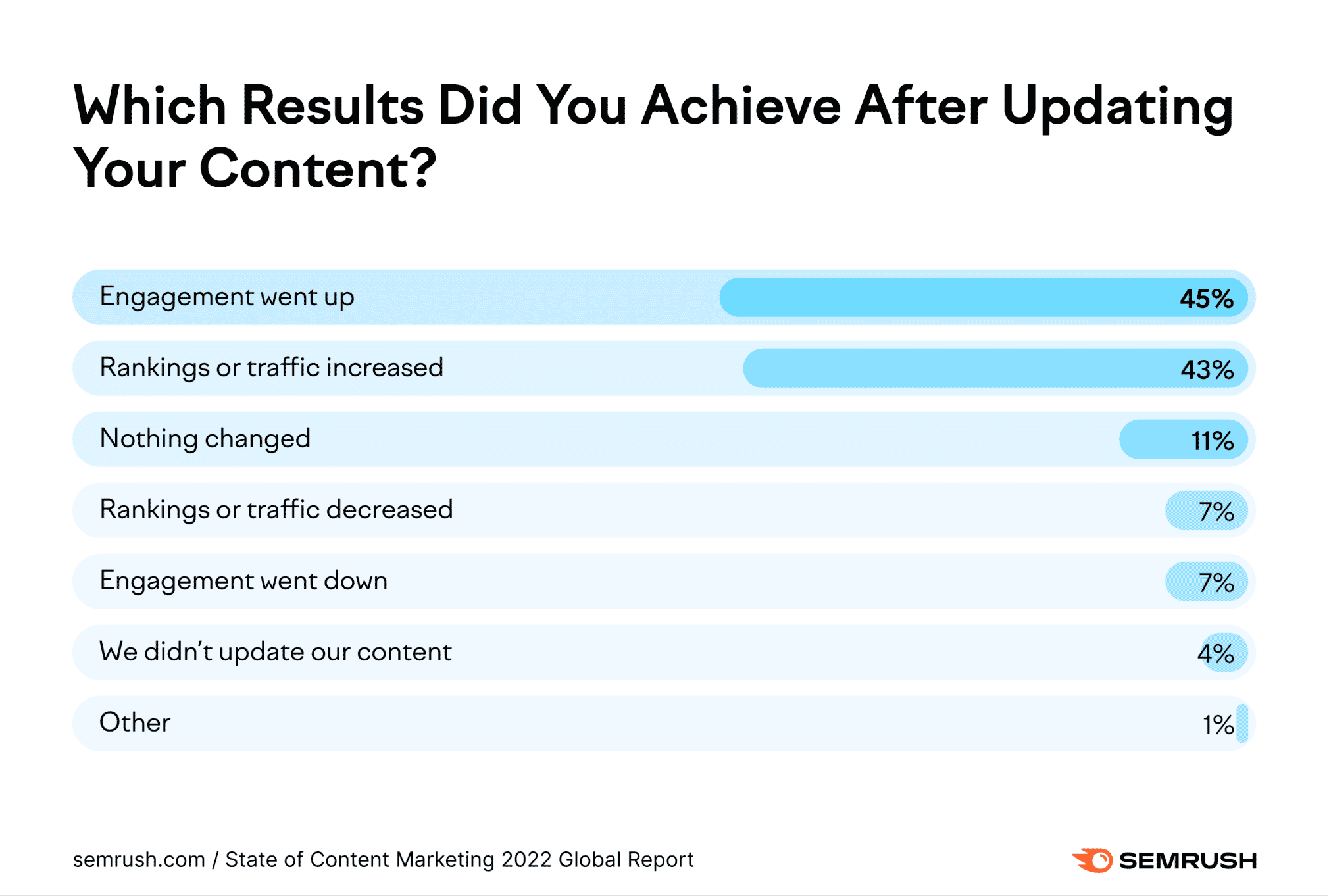
Content, of course, is not just done for SEO purposes and there are very good reasons and strategies for producing content that is meant for conversion only and not ranking.
When you decide to invest in SEO, you also need to invest in content that is driven by SEO keyword research.
Doing keyword research will then drive the following types of pages:
- Homepage (and its topic focus)
- Features and Benefits pages
- Blog posts
By using keyword research to drive how these pages are messaged, you can drive high intent traffic that is ready to convert, or at least ready to download a high-value resource you offer them.
Here’s our longer piece on content marketing for SEO.
Outreach, Links, Guest Posting, and Promotion
Finally, backlinks drive your rankings better than anything else.
While links have become less important over the years because of usage signals from around the internet, they do still drive rankings.
To be candid, link-building strategies come and go.
This is because something is found to work, then someone blogs about it or talks about it at a conference, and then it’s the strategy of the day and everyone does it.
Then it gets overplayed and commoditized and you end up with a bunch of bad spam “outreach” emails in your email inbox.
Let’s be candid about link building then. It is hard, it is time-consuming, it is expensive, and it has variable returns based on the strategies you employ.
The best way to build links is to create things that deserve to be linked to, then talk about them and where your ideal customer is.
A Note On Guest Posting
There are absolutely ways to build links that are a bit more manual, such as broken link building (finding resources that competitors have let lapse that has external links and doing outreach to get those links to your site), brand mention reclamation (monitoring for mentions of your brands and asking for a link), and even guest posting.
Guest posting has become quite spammy over the years, especially as blogs have become less popular or widely read.
While getting content on a well-read site is still a highly effective way to build your audience and high-quality links, the time you may have spent on guest blogging in 2011-2013 will likely be better spent being mentioned in well-read newsletters in 2021.
A few more good ways to build quality links in 2021 include:
- Being mentioned as a source in industry news outlets, by becoming friends with reporters and being a trusted source of information;
- Using HARO (Help A Reporter Out) to find opportunities for becoming a trusted source like above;
- Speaking at, and being linked from, conferences;
- Being a podcast guest to gain both audience and links from show notes;
- Creating best-in-class guides that become industry-standard resources and are linked to widely;
- Producing statistics from your own data that no one else in your industry can or will (this was Zillow’s strategy).
One easy way to find sites to prioritize who has linked to your competitors is to use Semrush‘s Backlink Gap tool.
This lets you find sites linking to your competitors who do not yet link to you:
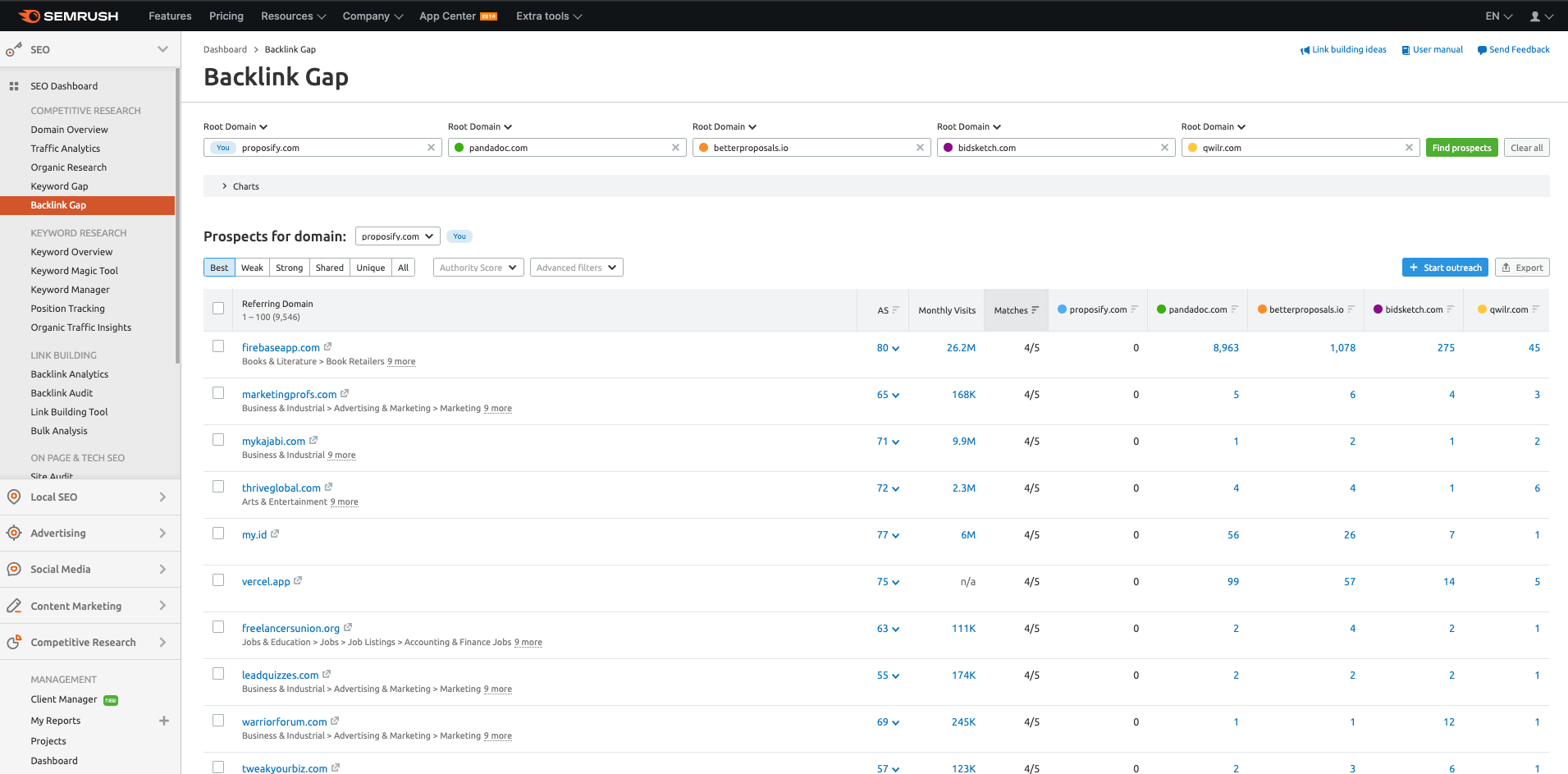
As you can see, the best way to build links in 2021 is by building relationships and being genuinely helpful to your industry.
Measure Your Conversions!
All too often, companies investing in SEO look at traditional SEO metrics like rankings and traffic to the exclusion of measuring the business metrics behind why you’re doing SEO in the first place.
You should absolutely measure rankings and traffic, as well as traffic to the important sections of your website that you’re targeting for improved rankings via specific technical, content, and link campaigns.
But at the end of the day, SEO needs to be adding to your bottom line and be return-on-investment positive just like any other channel.
If you’re spending $5k/mo on SEO and the three pillars that go with it, are you making more than an incremental $5k ARR from that month?
Before starting on your B2B SaaS SEO investment, it’s important to build out an SEO dashboard within your analytics dashboard tool of choice.
For most, that will simply be Google Analytics though if you want to get fancier and have an all-in-one dashboard you could use a tool like Databox, Klipfolio, or Google Data Studio to bring together not only your onsite metrics like traffic, but also data from other sources like Semrush where you track rankings.
Here’s an example of an Analytics SEO dashboard we use internally at Credo:
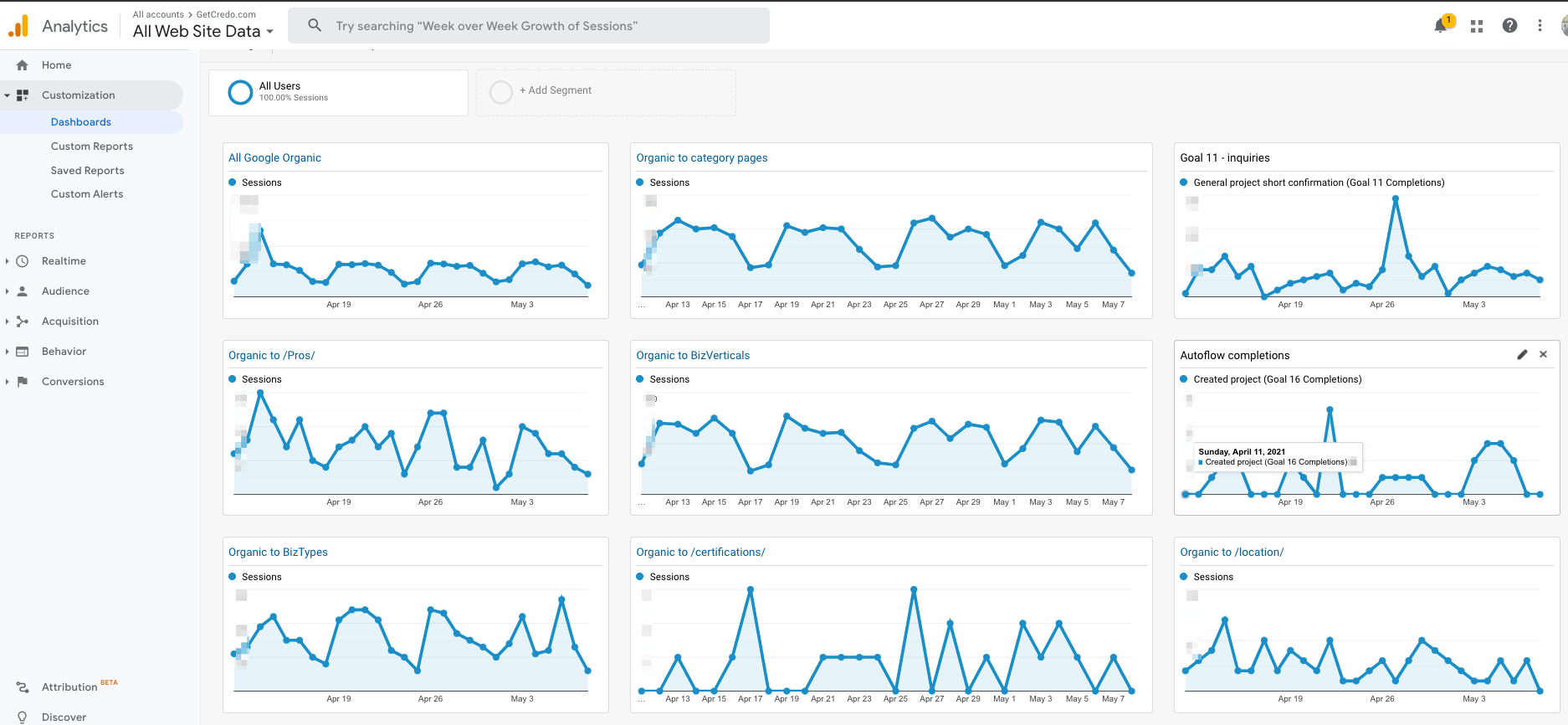
To create your own SEO Analytics dashboard, you should have at least the following metrics:
- Overall organic traffic
- Organic traffic by search engine (Google, Bing, DuckDuckGo)
- OT to important sections of your site (home, categories, features, blog posts)
- Organic conversions/goal completions by goal (resource download, contact form submitted, demo requested, demo scheduled, etc)
First off, just having goals set up for the purpose of this dashboard will serve your business well because you can actually see the results from your various marketing efforts.
Second, having a dashboard like this will let you compare year on year (I recommend using Metric Only reports for this so you get percentage comparisons) so you can see the results from your hard work and investment.
Third, make sure you’re tracking back to revenue.
You would be wise to not just track your conversion metrics onsite to demo/call/whatever your conversion funnel looks like, but also CAC and how sticky those customers are once they convert.
What you will probably find is that SEO traffic tends to convert at high rates. Plus, customers are acquired at a much lower CAC than paid acquisition.
A Final Word on B2B SaaS SEO
B2B SaaS is an interesting world to live in.
The best way to build a SaaS business through SEO is by content that meets your potential (and existing!) customers.
Meet them where they are. Do it so well that others can’t help but pay attention and link to you widely.
Couple this with a great story. One that solves an existing problem for a large industry.
That is the best way to win at SaaS SEO.
Why? Because you’ll be in a space that already has good search volume. It should be relatively easy to compete because your competitors are not amazing.
Even if they are, who cares?
By consistently looking to add value to your industry, you’re hard to beat.

